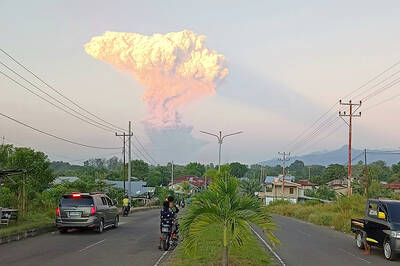Tsunami warnings were yesterday lifted across several South Pacific islands allowing tens of thousand of evacuees to return home, as the risk from a series of powerful earthquakes appeared to ease.
Earthquakes of magnitude 7.3, 7.4 and 8.1 struck near New Zealand’s remote Kermadec Islands in quick succession early on that day, followed by dozens of powerful aftershocks and a slew of tsunami warnings across the Pacific.
Thousands headed for high ground as waves of up to 3m had been predicted in New Caledonia and Vanuatu, with states and territories from New Zealand to Peru, Russia and Antarctica also put on high alert.

Photo: AP
In New Zealand, authorities said that the entire town of Opotiki, with a population of about 4,000, had been emptied out.
Six hours drive up the coast, Keith Wooderson said that he sought refuge in the hills outside town. “There were queues and queues of cars as far as the eye could see. We didn’t even get out of our van, we just waited for the all clear,” he said. “There was no panic, it was all pretty orderly.”
In the end, the largest surges of 1m were reported in New Caledonia’s Loyalty Islands, and eyewitnesses in Vanuatu’s capital, Port Vila, saw only a few outsized waves slosh against the seafront, soaking the pavement promenade.
There were no reports of major damage and the only immediate impact to human health appeared to be mild dehydration among commuters stuck for hours in heavy traffic on the French island of Tahiti.
The Pacific Tsunami Warning Center said that the threat had not completely ended — South and Central America could still see modest tsunami waves arriving from 1:30pm — but many warnings from local authorities were lifted.
Authorities in Australia, French Polynesia, New Caledonia, New Zealand and Vanuatu were among those rescinding or downgrading their initial warnings.
The sense of relief stood in stark contrast to early fears, when sirens rang out, seaside schools were evacuated and some parents were told to move to high ground immediately, without trying to collect their children — for fear that traffic would block emergency routes and leave many of them vulnerable or stranded.
New Zealand Prime Minister Jacinda Ardern expressed relief after evacuation orders for a swathe of coastal communities had been lifted.
“It’s hard not to feel like our country is having a run of bad luck, when you have an earthquake, a tsunami alert and a pandemic to contend with all in one day,” she said.
Fiona Rudsdale, who runs the Whangarei Central Holiday Park on New Zealand’s North Island, slept though the initial earthquake, but was woken by tsunami warning sirens.
She immediately began organizing the evacuation of about 30 guests from the caravan park to a nearby hilltop.
“We took them up to the top of Morningside Park. You can look down on the town from there,” Rudsdale said. “We put on some food and drink. It all went pretty smoothly. You’ve still got a couple of idiots in town driving around, but mostly everyone’s behaving themselves and doing what they’re told.”
In other areas, some hardy or foolish residents were seen braving the ocean for a swim or surf.
New Zealand Minister of Conservation Kiri Allan said that coastal communities responded to the warnings.
“Very swiftly, people pulled themselves together, got their backpacks, got into cars and congregated either inland or up high, and are now watching it unfold,” she said.
The local coastguard ordered hundreds of boats still on the ocean to deeper waters as a precaution.
The largest of the quakes struck abouit 1,000km off New Zealand’s coast at 8:28am, the US Geological Survey said.
It was preceded by two seismic jolts that were also enormously powerful, in an unusually strong cluster even for the Pacific “Ring of Fire,” where the Pacific Plate collides with several other tectonic plates.
“On average, a magnitude 8 or larger earthquake only occurs once a year anywhere in the world, so this is a significant earthquake and at a depth and magnitude to potentially generate a tsunami,” said Adam Pascale, a seismology researcher at ESS Earth Sciences.

Former Nicaraguan president Violeta Chamorro, who brought peace to Nicaragua after years of war and was the first woman elected president in the Americas, died on Saturday at the age of 95, her family said. Chamorro, who ruled the poor Central American country from 1990 to 1997, “died in peace, surrounded by the affection and love of her children,” said a statement issued by her four children. As president, Chamorro ended a civil war that had raged for much of the 1980s as US-backed rebels known as the “Contras” fought the leftist Sandinista government. That conflict made Nicaragua one of

COMPETITION: The US and Russia make up about 90 percent of the world stockpile and are adding new versions, while China’s nuclear force is steadily rising, SIPRI said Most of the world’s nuclear-armed states continued to modernize their arsenals last year, setting the stage for a new nuclear arms race, the Stockholm International Peace Research Institute (SIPRI) said yesterday. Nuclear powers including the US and Russia — which account for about 90 percent of the world’s stockpile — had spent time last year “upgrading existing weapons and adding newer versions,” researchers said. Since the end of the Cold War, old warheads have generally been dismantled quicker than new ones have been deployed, resulting in a decrease in the overall number of warheads. However, SIPRI said that the trend was likely

BOMBARDMENT: Moscow sent more than 440 drones and 32 missiles, Volodymyr Zelenskiy said, in ‘one of the most terrifying strikes’ on the capital in recent months A nighttime Russian missile and drone bombardment of Ukraine killed at least 15 people and injured 116 while they slept in their homes, local officials said yesterday, with the main barrage centering on the capital, Kyiv. Kyiv City Military Administration head Tymur Tkachenko said 14 people were killed and 99 were injured as explosions echoed across the city for hours during the night. The bombardment demolished a nine-story residential building, destroying dozens of apartments. Emergency workers were at the scene to rescue people from under the rubble. Russia flung more than 440 drones and 32 missiles at Ukraine, Ukrainian President Volodymyr Zelenskiy

Indonesia’s Mount Lewotobi Laki-Laki yesterday erupted again with giant ash and smoke plumes after forcing evacuations of villages and flight cancelations, including to and from the resort island of Bali. Several eruptions sent ash up to 5km into the sky on Tuesday evening to yesterday afternoon. An eruption on Tuesday afternoon sent thick, gray clouds 10km into the sky that expanded into a mushroom-shaped ash cloud visible as much as 150km kilometers away. The eruption alert was raised on Tuesday to the highest level and the danger zone where people are recommended to leave was expanded to 8km from the crater. Officers also